Abstract
Because of recent experimental data on the redox characteristics of cytochrome c oxidase and renewed interest in the role of cooperativity in energy coupling, the question of redox cooperativity in cytochrome c oxidase is reexamined. Extensive redox cooperativity between more than two redox centers, some of which are spectrally invisible, may be expected for this electron transfer coupled proton pump. Such cooperativity, however, cannot be revealed by the traditional potentiometric experiments based on a difference in absorbance between two wavelengths. Multiwavelength analyses utilizing singular value decomposition and second derivatives of absorbance vs. wavelength have revealed a stronger cooperativity than consistent with the "neoclassical" model, which allowed only for weak negative cooperativity between two equipotential one-electron centers. A thermodynamic analysis of redox cooperativity is developed, which includes the possibilities of strong cooperative redox interactions, the involvement of invisible redox centers, conformational changes, and monomer/dimer equilibrations. The experimental observation of an oxidation of one of the cytochromes (a3) with a decrease in applied redox potential is shown to require both strong negative cooperativity and the participation of more than two one-electron centers. A number of "modern" models are developed using the analytical approaches described in this paper. By testing with experimental data, some of these models are falsified, whereas some are retained with suggestions for further testing.
Full text
PDF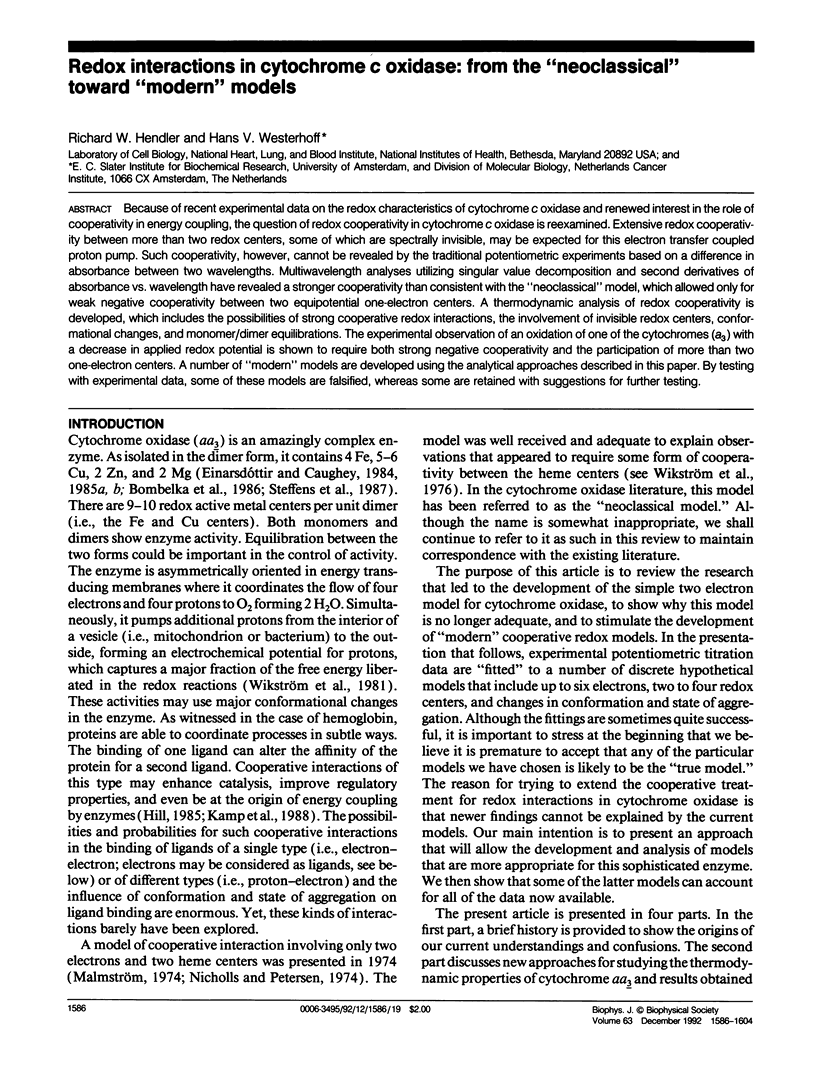

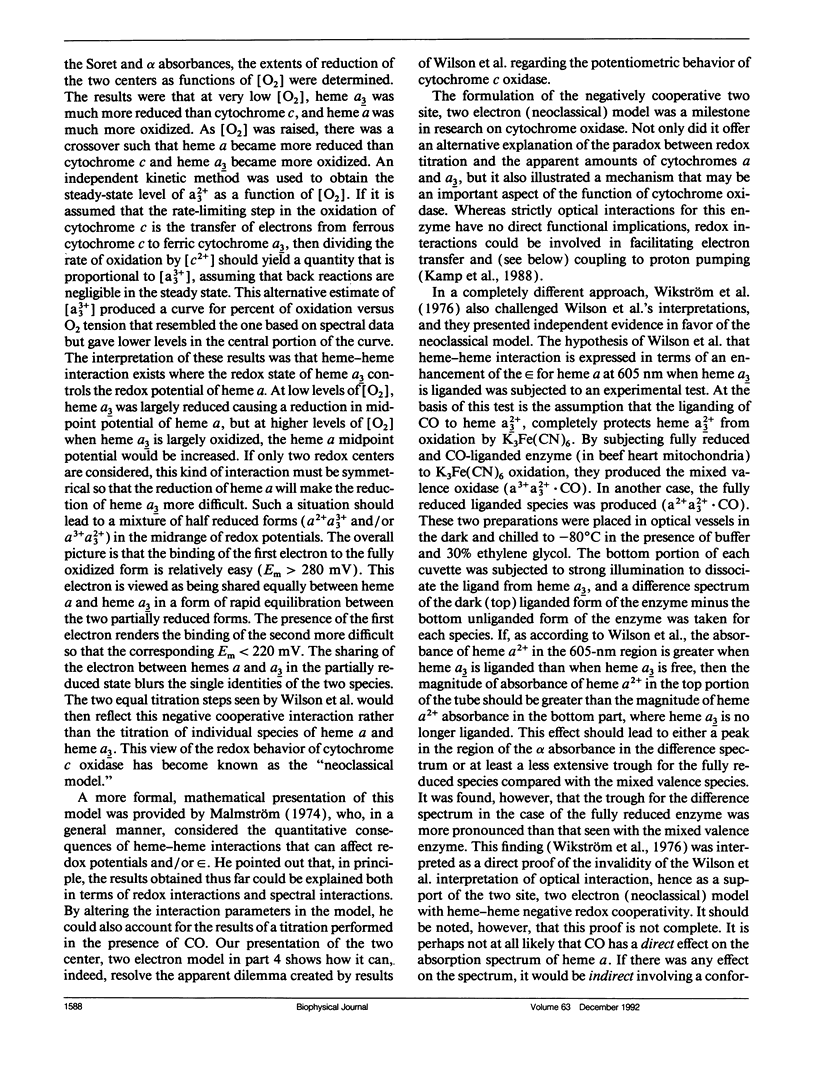
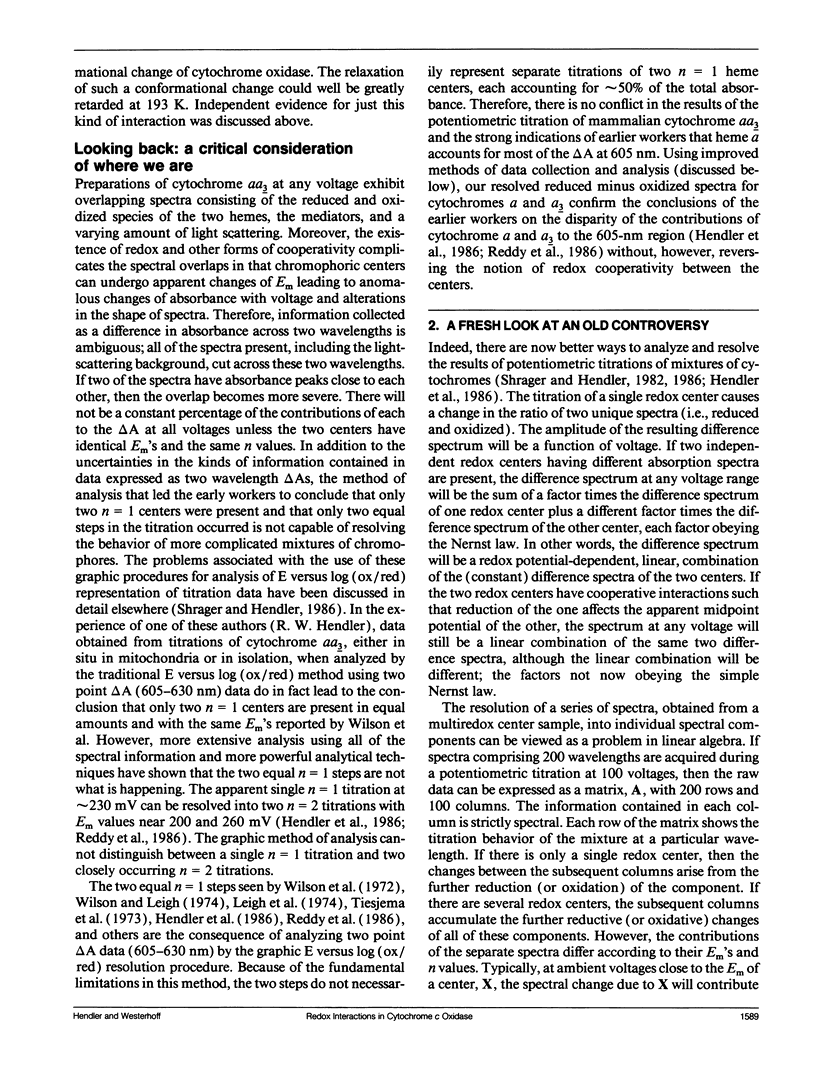
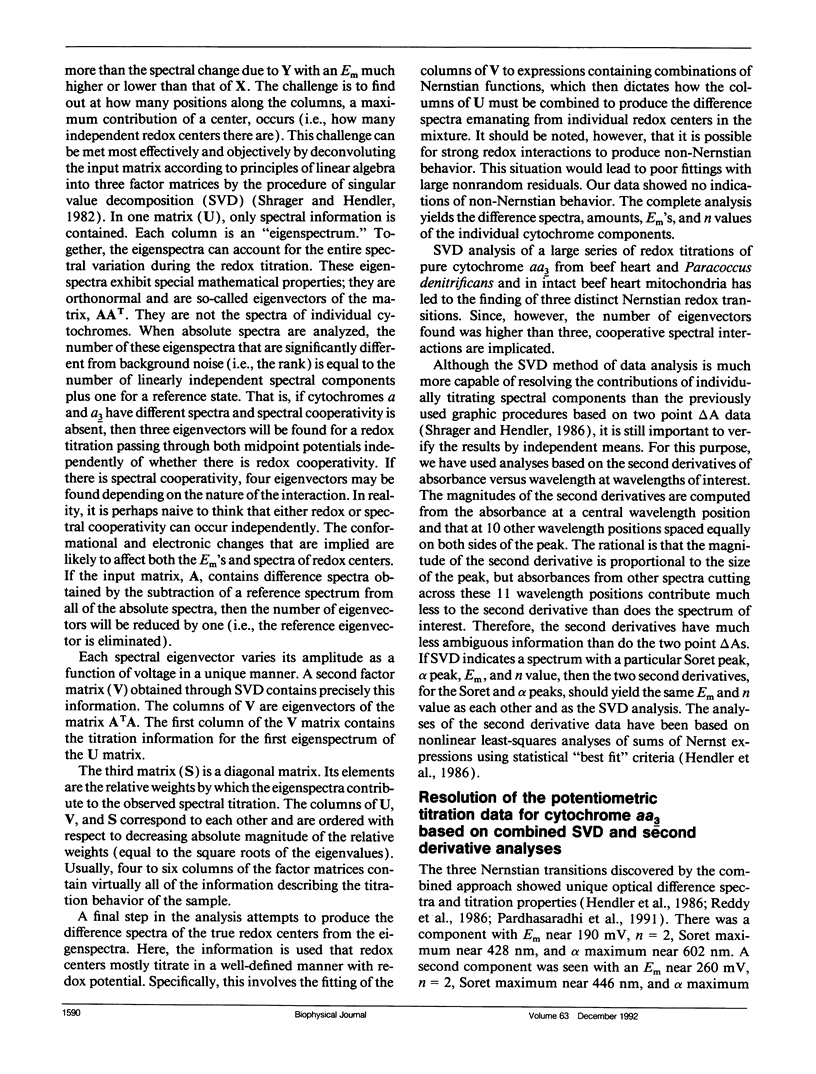
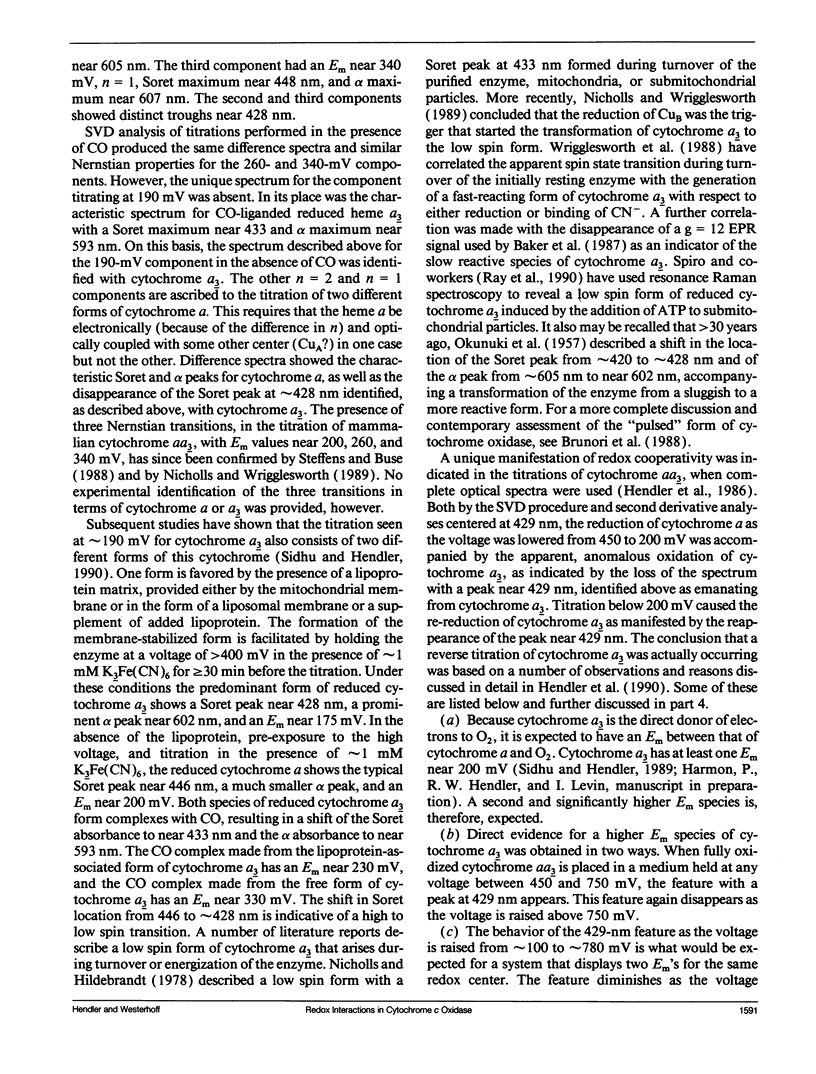


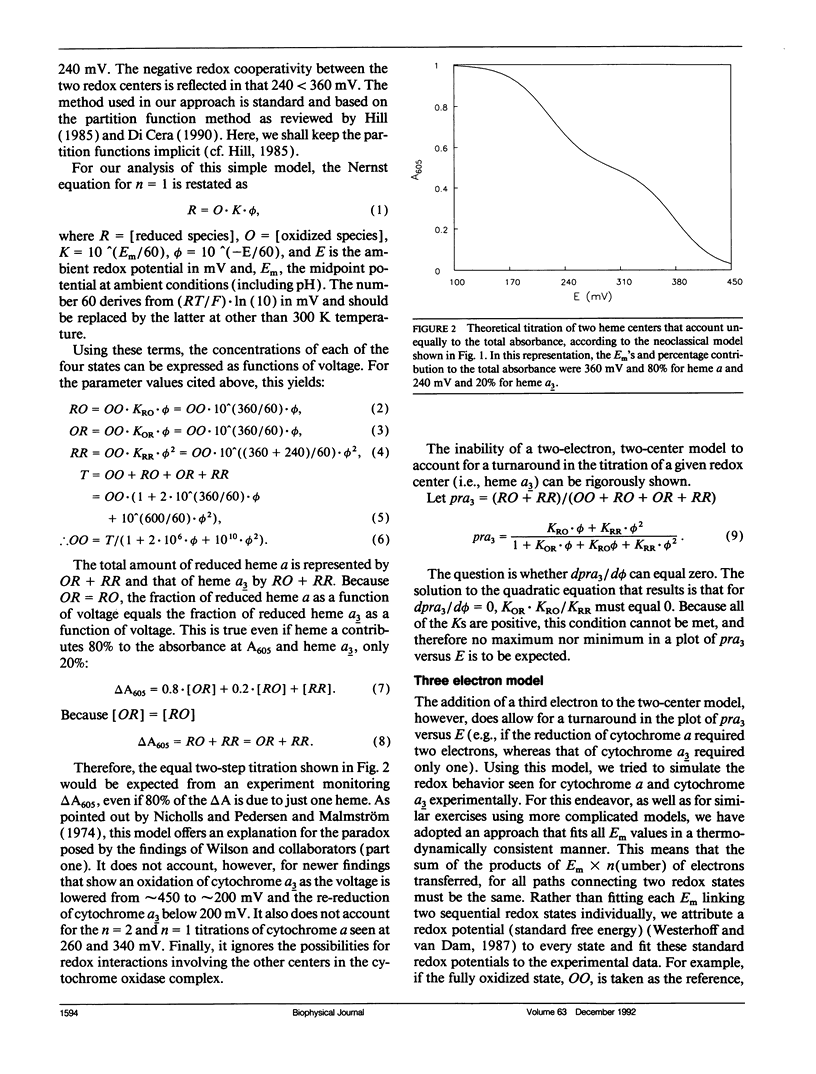

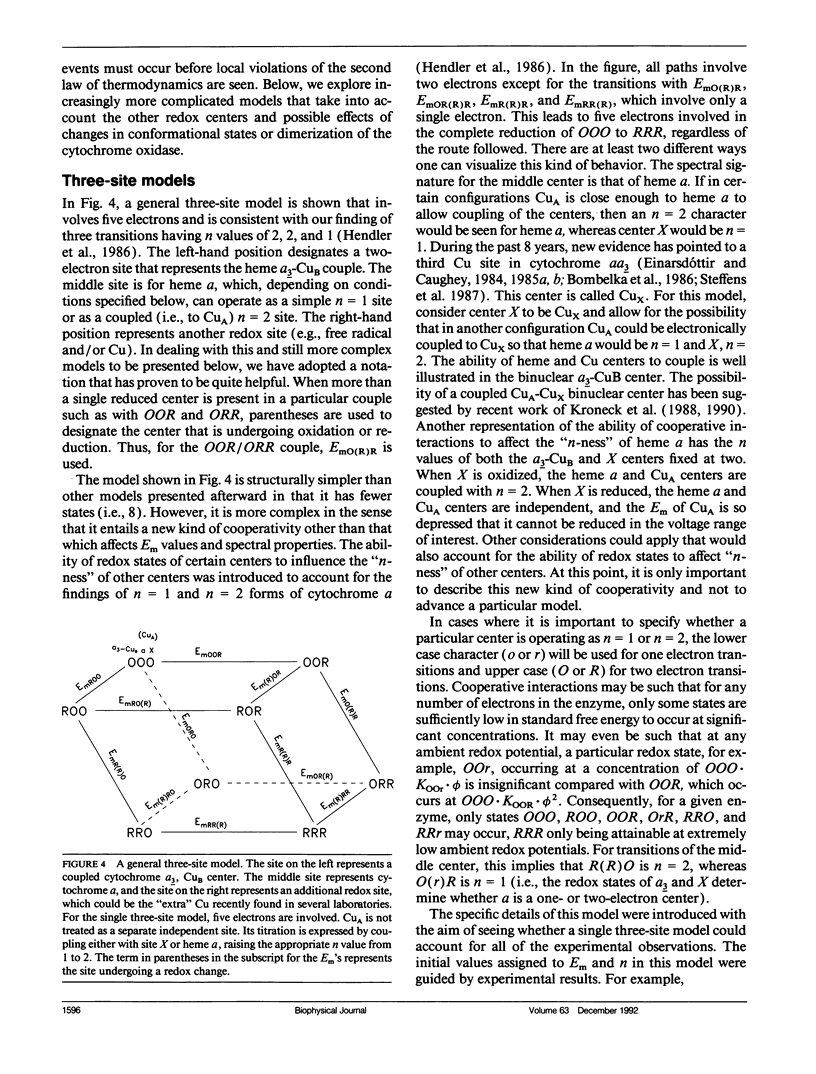
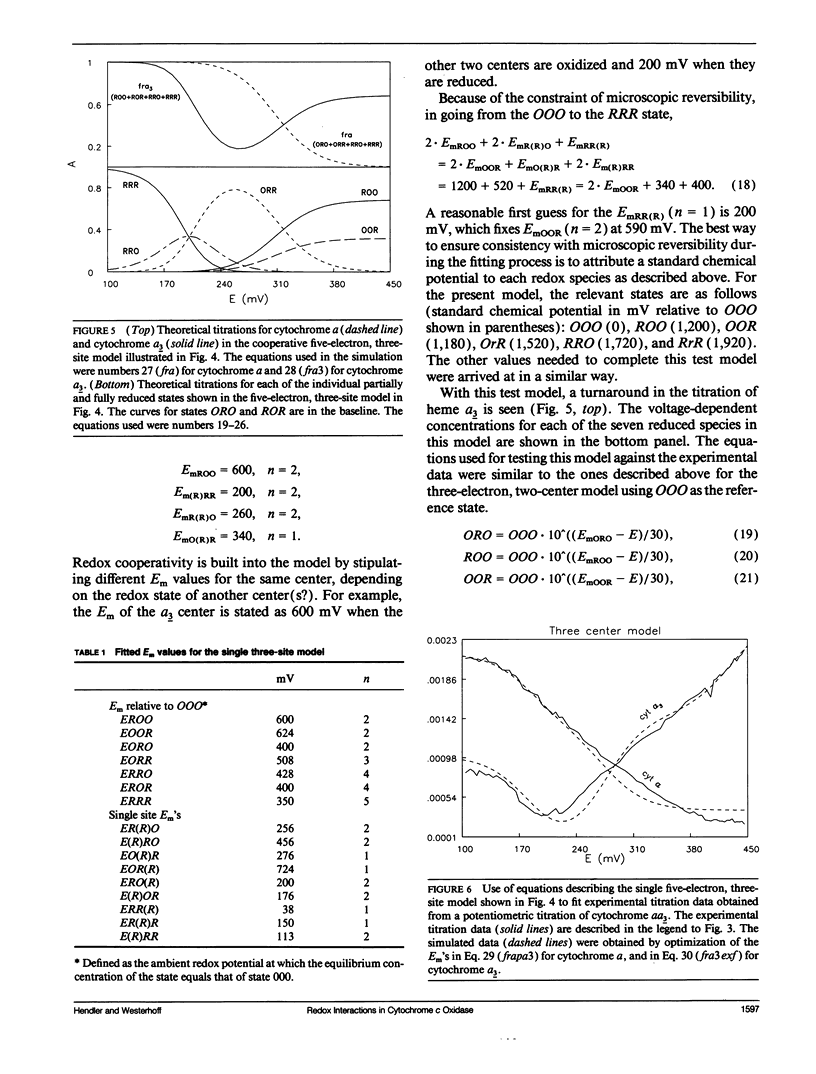



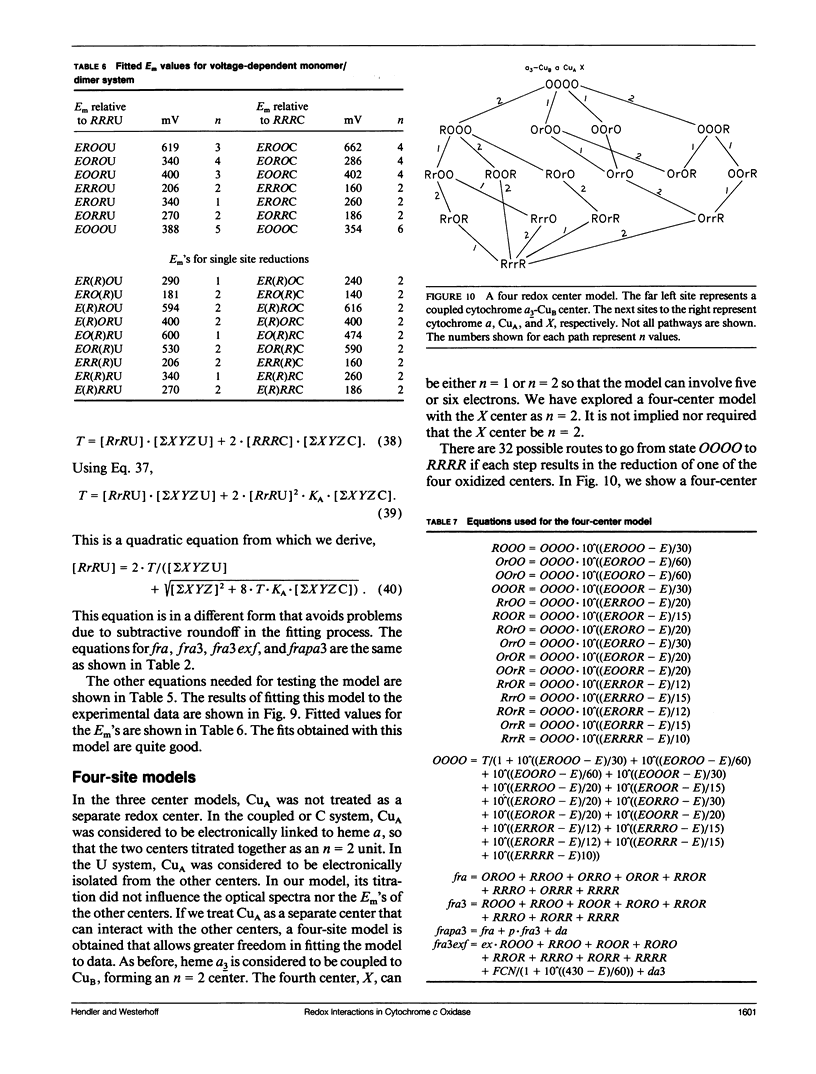
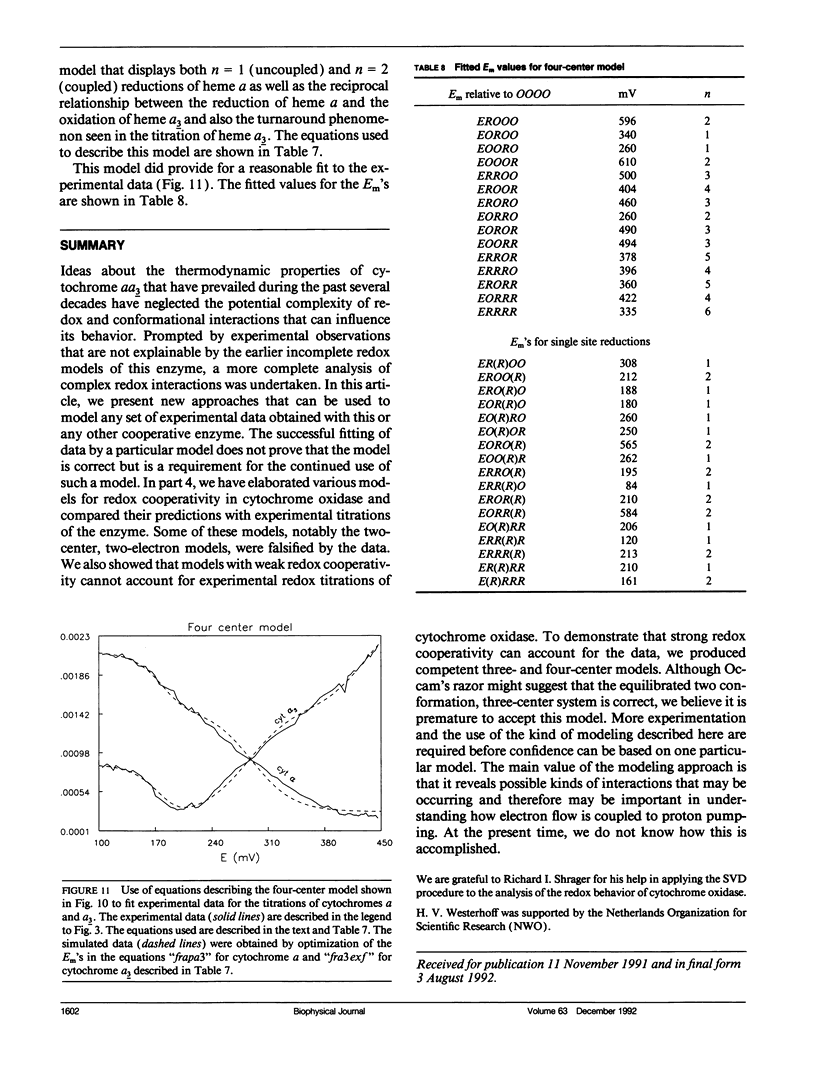


Selected References
These references are in PubMed. This may not be the complete list of references from this article.
- Baker G. M., Noguchi M., Palmer G. The reaction of cytochrome oxidase with cyanide. Preparation of the rapidly reacting form and its conversion to the slowly reacting form. J Biol Chem. 1987 Jan 15;262(2):595–604. [PubMed] [Google Scholar]
- Bombelka E., Richter F. W., Stroh A., Kadenbach B. Analysis of the Cu, Fe, and Zn contents in cytochrome C oxidases from different species and tissues by proton-induced X-ray emission (PIXE). Biochem Biophys Res Commun. 1986 Nov 14;140(3):1007–1014. doi: 10.1016/0006-291x(86)90735-7. [DOI] [PubMed] [Google Scholar]
- Brunori M., Antonini G., Malatesta F., Sarti P., Wilson M. T. Structure and function of cytochrome oxidase: a second look. Adv Inorg Biochem. 1988;7:93–153. [PubMed] [Google Scholar]
- Di Cera E. Thermodynamics of local linkage effects. Contracted partition functions and the analysis of site-specific energetics. Biophys Chem. 1990 Aug 31;37(1-3):147–164. doi: 10.1016/0301-4622(90)88015-k. [DOI] [PubMed] [Google Scholar]
- Einarsdóttir O., Caughey W. S. Bovine heart cytochrome c oxidase preparations contain high affinity binding sites for magnesium as well as for zinc, copper, and heme iron. Biochem Biophys Res Commun. 1985 Jun 28;129(3):840–847. doi: 10.1016/0006-291x(85)91968-0. [DOI] [PubMed] [Google Scholar]
- Einarsdóttir O., Caughey W. S. Zinc is a constituent of bovine heart cytochrome c oxidase preparations. Biochem Biophys Res Commun. 1984 Nov 14;124(3):836–842. doi: 10.1016/0006-291x(84)91033-7. [DOI] [PubMed] [Google Scholar]
- Einarsdóttir O., Choc M. G., Weldon S., Caughey W. S. The site and mechanism of dioxygen reduction in bovine heart cytochrome c oxidase. J Biol Chem. 1988 Sep 25;263(27):13641–13654. [PubMed] [Google Scholar]
- HORIE S., MORRISON M. CYTOCHROME C OXIDASE COMPONENTS.III. SPECTRAL PROPERTIES OF CYTOCHROMES A AND A3. J Biol Chem. 1963 Aug;238:2859–2865. [PubMed] [Google Scholar]
- Hendler R. W. Can ferricyanide oxidize carbon monoxide-liganded cytochrome a3? J Bioenerg Biomembr. 1991 Oct;23(5):805–817. doi: 10.1007/BF00786002. [DOI] [PubMed] [Google Scholar]
- Hendler R. W., Reddy K. V., Shrager R. I., Caughey W. S. Analysis of the spectra and redox properties of pure cytochromes aa3. Biophys J. 1986 Mar;49(3):717–729. doi: 10.1016/S0006-3495(86)83698-0. [DOI] [PMC free article] [PubMed] [Google Scholar]
- Hendler R. W., Sidhu G. S. A new high potential redox transition for cytochrome aa3. Biophys J. 1988 Jul;54(1):121–133. doi: 10.1016/S0006-3495(88)82937-0. [DOI] [PMC free article] [PubMed] [Google Scholar]
- Hendler R. W., Sidhu G. S., Pardhasaradhi K. High voltage redox properties of cytochrome c oxidase. Biophys J. 1990 Oct;58(4):957–967. doi: 10.1016/S0006-3495(90)82440-1. [DOI] [PMC free article] [PubMed] [Google Scholar]
- Kamp F., Astumian R. D., Westerhoff H. V. Coupling of vectorial proton flow to a biochemical reaction by local electric interactions. Proc Natl Acad Sci U S A. 1988 Jun;85(11):3792–3796. doi: 10.1073/pnas.85.11.3792. [DOI] [PMC free article] [PubMed] [Google Scholar]
- Kojima N., Palmer G. Further characterization of the potentiometric behavior of cytochrome oxidase. Cytochrome alpha stays low spin during oxidation and reduction. J Biol Chem. 1983 Dec 25;258(24):14908–14913. [PubMed] [Google Scholar]
- Kroneck P. M., Antholine W. A., Riester J., Zumft W. G. The cupric site in nitrous oxide reductase contains a mixed-valence [Cu(II),Cu(I)] binuclear center: a multifrequency electron paramagnetic resonance investigation. FEBS Lett. 1988 Dec 19;242(1):70–74. doi: 10.1016/0014-5793(88)80987-6. [DOI] [PubMed] [Google Scholar]
- Kroneck P. M., Antholine W. E., Kastrau D. H., Buse G., Steffens G. C., Zumft W. G. Multifrequency EPR evidence for a bimetallic center at the CuA site in cytochrome c oxidase. FEBS Lett. 1990 Jul 30;268(1):274–276. doi: 10.1016/0014-5793(90)81026-k. [DOI] [PubMed] [Google Scholar]
- Leigh J. S., Jr, Wilson D. F., Owen C. S., King T. E. Heme-heme interaction in cytochrome c oxidase: the cooperativity of the hemes of cytochrome c oxidase as evidenced in the reaction with CO. Arch Biochem Biophys. 1974 Feb;160(2):476–486. doi: 10.1016/0003-9861(74)90424-x. [DOI] [PubMed] [Google Scholar]
- Malmström B. G. Cytochrome c oxidase: some current biochemical and biophysical problems. Q Rev Biophys. 1973 Nov;6(4):389–431. doi: 10.1017/s0033583500001578. [DOI] [PubMed] [Google Scholar]
- Nicholls P., Hildebrandt V. Binding of ligands and spectral shifts in cytochrome c oxidase. Biochem J. 1978 Jul 1;173(1):65–72. doi: 10.1042/bj1730065. [DOI] [PMC free article] [PubMed] [Google Scholar]
- Nicholls P., Petersen L. C. Haem-haem interactions in cytochrome aa3 during the anaerobic-aerobic transition. Biochim Biophys Acta. 1974 Sep 20;357(3):462–467. doi: 10.1016/0005-2728(74)90038-3. [DOI] [PubMed] [Google Scholar]
- Nicholls P., Wrigglesworth J. M. Routes of cytochrome a3 reduction. The neoclassical model revisited. Ann N Y Acad Sci. 1988;550:59–67. doi: 10.1111/j.1749-6632.1988.tb35323.x. [DOI] [PubMed] [Google Scholar]
- Pardhasaradhi K., Ludwig B., Hendler R. W. Potentiometric and spectral studies with the two-subunit cytochrome aa3 from Paracoccus denitrificans. Comparison with the 13-subunit beef heart enzyme. Biophys J. 1991 Aug;60(2):408–414. doi: 10.1016/S0006-3495(91)82066-5. [DOI] [PMC free article] [PubMed] [Google Scholar]
- Ray G. B., Copeland R. A., Lee C. P., Spiro T. G. Resonance Raman evidence for low-spin Fe2+ heme a3 in energized cytochrome c oxidase: implications for the inhibition of O2 reduction. Biochemistry. 1990 Apr 3;29(13):3208–3213. doi: 10.1021/bi00465a009. [DOI] [PubMed] [Google Scholar]
- Reddy K. V., Hendler R. W., Bunow B. Complete analysis of the cytochrome components of beef heart mitochondria in terms of spectra and redox properties. Cytochromes aa3. Biophys J. 1986 Mar;49(3):705–715. doi: 10.1016/S0006-3495(86)83697-9. [DOI] [PMC free article] [PubMed] [Google Scholar]
- Sherman D., Kotake S., Ishibe N., Copeland R. A. Resolution of the electronic transitions of cytochrome c oxidase: evidence for two conformational states of ferrous cytochrome alpha. Proc Natl Acad Sci U S A. 1991 May 15;88(10):4265–4269. doi: 10.1073/pnas.88.10.4265. [DOI] [PMC free article] [PubMed] [Google Scholar]
- Shrager R. I., Hendler R. W. Processing and analysis of potentiometric data. Biophys J. 1986 Mar;49(3):687–691. doi: 10.1016/S0006-3495(86)83695-5. [DOI] [PMC free article] [PubMed] [Google Scholar]
- Sidhu G. S., Hendler R. W. Characterization of two low Em forms of cytochrome a3 and their carbon monoxide complexes in mammalian cytochrome c oxidase. Biophys J. 1990 Jun;57(6):1125–1140. doi: 10.1016/S0006-3495(90)82633-3. [DOI] [PMC free article] [PubMed] [Google Scholar]
- Steffens G. C., Biewald R., Buse G. Cytochrome c oxidase is a three-copper, two-heme-A protein. Eur J Biochem. 1987 Apr 15;164(2):295–300. doi: 10.1111/j.1432-1033.1987.tb11057.x. [DOI] [PubMed] [Google Scholar]
- Tiesjema R. H., Muijsers A. O., van Gelder B. F. Biochemical and biophysical studies on cytochrome c oxidase. X. Spectral and potentiometric properties of the hemes and coppers. Biochim Biophys Acta. 1973 Apr 27;305(1):19–28. doi: 10.1016/0005-2728(73)90227-2. [DOI] [PubMed] [Google Scholar]
- Tsudzuki T., Wilson D. F. The oxidation-reduction potentials of the hemes and copper of cytochrome oxidase from beef heart. Arch Biochem Biophys. 1971 Jul;145(1):149–154. doi: 10.1016/0003-9861(71)90021-x. [DOI] [PubMed] [Google Scholar]
- Vanneste W. H. The stoichiometry and absorption spectra of components a and a-3 in cytochrome c oxidase. Biochemistry. 1966 Mar;5(3):838–848. doi: 10.1021/bi00867a005. [DOI] [PubMed] [Google Scholar]
- Walz D. Thermodynamics of oxidation-reduction reactions and its application to bioenergetics. Biochim Biophys Acta. 1979 Mar 14;505(3-4):279–353. doi: 10.1016/0304-4173(79)90007-7. [DOI] [PubMed] [Google Scholar]
- Wikström K. F., Harmon H. J., Ingledew W. J., Chance B. A re-evaluation of the spectral, potentiometric and energy-linked properties of cytochrome c oxidase in mitochondria. FEBS Lett. 1976 Jun 15;65(3):259–277. doi: 10.1016/0014-5793(76)80127-5. [DOI] [PubMed] [Google Scholar]
- Wilson D. F., Dutton P. L. The oxidation-reduction potentials of cytochromes a and a3 in intact rat liver mitochondria. Arch Biochem Biophys. 1970 Feb;136(2):583–585. doi: 10.1016/0003-9861(70)90233-x. [DOI] [PubMed] [Google Scholar]
- Wilson D. F., Leigh J. S. Heme-heme interaction between the cytochromes of the mitochondrial respiratory chain. Ann N Y Acad Sci. 1974 Feb 18;227:630–635. doi: 10.1111/j.1749-6632.1974.tb14427.x. [DOI] [PubMed] [Google Scholar]
- Wilson D. F., Lindsay J. G., Brocklehurst E. S. Heme-heme interaction in cytochrome oxidase. Biochim Biophys Acta. 1972 Feb 28;256(2):277–286. doi: 10.1016/0005-2728(72)90058-8. [DOI] [PubMed] [Google Scholar]
- Wrigglesworth J. M., Elsden J., Chapman A., Van der Water N., Grahn M. F. Activation by reduction of the resting form of cytochrome c oxidase: tests of different models and evidence for the involvement of CuB. Biochim Biophys Acta. 1988 Dec 7;936(3):452–464. doi: 10.1016/0005-2728(88)90023-0. [DOI] [PubMed] [Google Scholar]
- YONETANI T. Studies on cytochrome oxidase. I. Absolute and difference absorption spectra. J Biol Chem. 1960 Mar;235:845–852. [PubMed] [Google Scholar]
- YONETANI T. Studies on cytochrome oxidase. II. Steady state properties. J Biol Chem. 1960 Nov;235:3138–3143. [PubMed] [Google Scholar]
- Yoshikawa S., Caughey W. S. Heart cytochrome c oxidase. An infrared study of effects of oxidation state on carbon monoxide binding. J Biol Chem. 1982 Jan 10;257(1):412–420. [PubMed] [Google Scholar]
- Yoshikawa S., Caughey W. S. Infrared evidence of azide binding to iron, copper, and non-metal sites in heart cytochrome c oxidase. J Biol Chem. 1992 May 15;267(14):9757–9766. [PubMed] [Google Scholar]
- Yoshikawa S., O'Keeffe D. H., Caughey W. S. Investigations of cyanide as an infrared probe of hemeprotein ligand binding sites. J Biol Chem. 1985 Mar 25;260(6):3518–3528. [PubMed] [Google Scholar]


